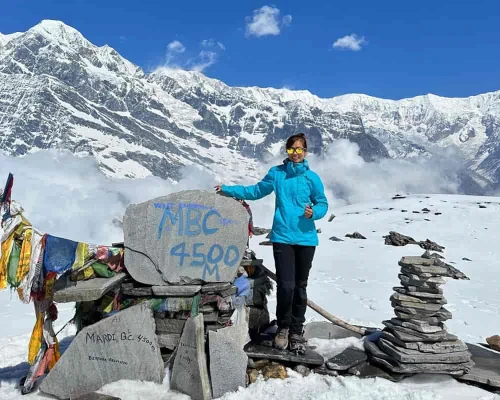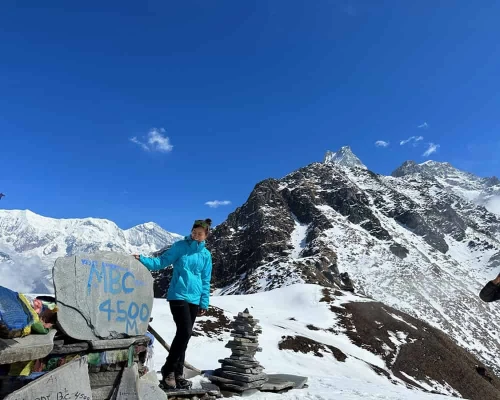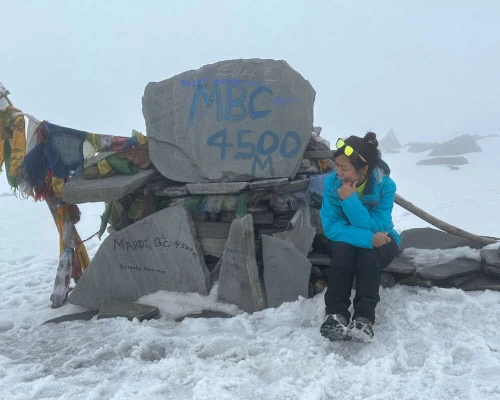Mardi Himal Trek Overview
Signing up for Mardi Himal Trek is a great way to escape from the maddening commercial trekking destination. It takes you into the heavenly, serene, and less-trodden trekking route. Furthermore, this very untouched Himalayan setting of Mardi has truly been termed as the hidden gem.
The Trek to Mardi Himal is certainly a breathtaking journey through the majestic Himalayan wilderness. It offers you the closest view of Annapurna South, Hiunchuli, iconic Machhapuchhre (Fishtail), and Mardi Himal. Unlike the Annapurna Base Camp Trek, the Mardi Himal Trek provides a serene and mindful experience. It allows travelers to witness the raw beauty of Nepal's Himalayan landscapes, making it a perfect alternative to overcrowded trekking destinations.
Furthermore, this 10-day epic teahouse Mardi Himal Fishtail trek is one of the most beautiful treks in the Annapurna trekking destination category. It is an off-the-beaten-track and less trodden route that offers anyone a genuine wilderness trekking experience.
Additionally, Mardi Himal Trek delivers outstanding mountain views and the serenity of the valley. It allows you to escape from the commercial trekking trails and takes you into the pristine landscape. Furthermore, this newly opened trekking destination cruises through the traditional GURUNG and MAGAR villages, and the untouched mountain terrains.
Being a relatively new trekking destination, the valley of Mardi Himal is still very untouched by the influence of mass tourism. So to say you can enjoy your solitude and breathe fresh air without intrusion from mass hikers.
Check this Ultimate Guide to Mardi Himal Trek for more detailed information.
Mardi Himal Trek Highlights
- Scenic Flight from Kathmandu to Pokhara.
- Enjoy the most dramatic aerial view as you fly to Pokhara with snowcapped mountains on the horizon.
- Explore Pokhara (820 meters), visit the Phewa or Fewa Lake, and watch the lake mirroring the Annapurna range.
- Majestic view of the Holy Machhapuchare mountain (Mt. Fishtail at 6,993 m), and Annapurna Range.
- Connect with nature and enjoy the serenity of a less crowded trail of Mardi.
- Experience off-the-beaten-track adventure through the most dramatic woodland of Oak, Rhododendron, and Maple.
- Walk on the NEWLY OPENED trail with traditional teahouse facilities and great local hospitality.
- Hike to the alpine landscape setting of Mardi Himal Base Camp at 4500 m / 14,763 feet.
- Enjoy the experience of the pristine mountains, ridges, and Himalayan meadows.
- Descend to the traditional settlement of GURUNGS and relax in the most beautiful homestay setting.
History of Mardi Himal (5,587 m / 18,330 feet)
Mardi Himal is a small mountain peak that stands alongside the prominent Machapuchare Mountain (Mt. Fishtail). In fact, it looks more like a part of Fishtail Mountain but still holds great significance. The height of Mardi Himal is 5,587 m / 18,330 feet and looks pretty small alongside the majestic Machapuchare (6,993 m / 22,943 feet).
The Mardi Himal, as a trekking peak, was recognized only very recently. However, the stunning trek to the base of Mardi Himal was opened only in 2012. Before that, the area was restricted for trekking purposes and was opened only for mountaineering expeditions.
The history of Mardi Himal dates back to 1961, when Lt. Col Jimmy Roberts (J. O. M. Roberts) got special permission to explore far and wide in Nepal. The first recorded ascent of Mardi Himal was made in 1961 by a team of British mountaineers.
The team was led by Lt. Col. Jimmy Roberts, including Colonel Basil Goodfellow, British Chief Commander, and two Sherpa climbers, Ang Nyima and Kusang Sherpa. They climbed the peak via the southeast ridge, which is still the most popular route to the summit.
Over the years, eventually, the government of Nepal opened Mardi Himal and its route for trekking in 2012. Surprisingly, the Mardi Himal route didn't take long to get popular, it quickly gained popularity among trekkers. It delivered a less crowded and more off-the-beaten-path experience in the Annapurna region.
The trek to Mardi Himal Base Camp (4500 meters) takes about a week and offers stunning views of the Machhapuchhre and Annapurna mountain ranges. Now, it is considered one of the most spectacular trekking destinations in the Annapurna region, offering pristine mountain views.
Despite being a newly opened trekking destination, Mardi Himal today attracts thousands of trekkers each year. The trek is known for its diverse landscapes, including lush forests and high-altitude meadows, as well as magical views of mountains and the surrounding landscapes.
The ascent of Machapuchare and Mardi Himal:
There is a beautiful history of how Mardi Himal came into existence. It dates back to 1957 when the British team led by Lieutenant Colonel Jimmy Roberts tried to climb Machapuchare Mountain. Machapuchare Peak, which is 6,993 m / 22,943 feet, is now very popularly known as MT. FISHTAIL. The shapely spire of Machapuchare is one of Nepal’s most striking sights.
A small expedition led by Lieutenant Colonel Jimmy Roberts and Wilfred Noyce had attempted to climb from its north ridge in 1957. However, the expedition had to be abandoned within 50m of its summit, either out of respect for the locals or due to the Sherpas' refusal to carry on. After this attempt, the government prohibited further climbing on the mountain, so technically it remains unclimbed to date.
However, over time, climbers on their quest to Machapuchae Peak discovered an anonymous peak, which is now Mardi Himal. Mardi Himal was first climbed in 1961 by Colonel Basil Goodfellow, the Chief Commander of the British troops.
Enchanting Mardi Himal Trek:
If you are signing up for the Mardi Himal Trek, then prepare yourself for the most phenomenal Himalayan Experience. Not to mention, the impressive beauty, untouched trail, and magical rhododendron forest give you the taste of a genuine trekking feeling. Since the Mardi Himal trail was opened very recently, the accommodation facility is quite basic. Despite the basic provisions of the tea houses in the region, it is worth visiting for its fascination.
It takes you to the exotic and fascinating trail through lush, vibrant valleys. Furthermore, the alpine meadows, dense forests, a series of waterfalls, and mesmerizing views of soaring peaks upon the skyline are sensational. Comparatively, It is suitable for anyone who wishes to taste the real trekking experience.
The Mardi Himal Trek is indeed a hidden treasure. The region very well conserves the serenity of both flora and fauna. It is more about giving yourself a chance to understand the local culture, experience the genuine wilderness, try local delicacies, and make the most out of your travel understanding.
The panoramic views of the massive Himalayan Mountains, including the Annapurna range, Machhapuchre (Fishtail), Hiunchuli, Mardi Himal, etc are simply Phenomenal. Come one, come all, and experience the journey of a lifetime. Trekkers also look for Annapurna Base Camp with the Mardi Himal Trek.
Mardi Himal Base Camp 4,500 m/14,763 feet:
The enchanting Mardi Base Camp (MBC) is at a height of 4,500 m/14,763 feet. Starting from the High Camp we will ascend a steeply vertical step trail towards the Viewpoint which is at 4,200 meters. There are a few basic teashops at the viewpoint where we will give ourselves a quick stop for a tea and enjoy the view.
After the viewpoint, we will be walking on the ridgeline in a breathtaking alpine meadow that offers the raw beauty of the Himalayan landscape. This serene and untouched section of the trail provides a magical panoramic view of Nepal's most iconic peaks like the sacred Machapuchare (Fishtail Mountain), Mardi Himal, Annapurna South, Hiunchuli, and many more.
Furthermore, the extension of the landscape that looks like waves among the settled cloud is another enchanting view. The base camp sits like a hidden jewel that is surrounded by rugged terrain, towering mountains, and a dramatic landscape setting. At Mardi Base Camp you will discover your solitude and witness a deep connection with nature.
The alpine meadow at Mardi Himal Base Camp is a vantage point framed by a theatrical landscape setting where you simply want to spend the rest of your time. Here, in profound silence, you lose yourself. After a while, it will be time to head back to our lodge and you are not ready for it, you simply want to get dissolved into this magical moment.
Mardi Himal Trek Quick Facts:
Location:
- Annapurna region, Nepal.
- A very new trekking destination which was opened only in 2012.
Accessibility:
- Easy, reachable by a short drive from Pokhara.
Duration & Distance:
- 40 km (25 miles)
- Can be completed in 5/7 days.
Maximum Altitude:
- Mardi Himal Base Camp at 4,500 meters / 14,763 feet.
Difficulty Level:
- Moderate and it is suitable for all age groups and beginners.
Daily Hiking Duration:
- 5/6 hours, covering approximately 08-15 kilometers.
Mountain Views:
- Stunning view of Annapurna South (7,219 m), Machhapuchhre (6,993 m), Gangapurna, and Mardi Himal (5,587 m) etc.
Accommodation and Food:
- Basic tea houses with local Nepali dishes and Western food options.
Unique Features:
- Less crowded, very peaceful, solitude, and pristine landscapes.
Best Time to Visit:
- Spring, Autumn, and Winter.
Permits Requirements:
- Annapurna Conservation Area Project Permit (ACAP), cost NPR 3000 per person.













